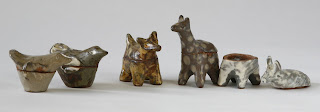
In 2001 Michael spent 7 months studying
Onggi with Mr. Oh. At that time Mr.Oh owned a factory near Kwangju, half of the factory made jiggered very small
Onggi jars that were used as packaging for high end soy sauce and soy bean paste. The other half was devoted to making hand made traditional
Onggi pots. Before 1980 there were 100s of
Onggi kilns all over Korea but the 70's and 80's saw a rapid decline in hand made
Onggi as people moved into apartments and no longer had space for
Onggi. Also plastic and large jiggered
Onggi replaced the old jars. Because Mr. Oh worked in
Onggi potteries before most of them closed down, he got to know a lot of old
Onggi masters. When we would drive around he would point out places where displaced
Onggi potters worked. He would say " the guy pumping gas at that gas station used to be the best at making bottles, the security guard at that elementary school was the best at making the giant rice wine jars, the mechanic at that garage was the best at glazing" etc. He was able to hire some of these potters to work in the hand made part of his factory. When I was there, Mr. Oh had 6 wheels where old
Onggi masters and students would work together making the production line of traditional forms. Mr. Oh
unfortunately had little time to make anything himself because he had to run such a large operation.

Above is a photo of Mr. Yang, the old master who I worked with the most. At some points it was just he and I making the pots. My job was to bring him clay, glaze the pots, load the kiln, put spouts on pots, etc.,while he cranked pots. Below we are making clay in the funky old, diesel, Doctor Seuss roller crusher.

Glazing a big jar.... These large jars were an order from a rice wine company. If I threw out slabs for him, Mr. Oh could make two of these in a day.

In my free time I would practice making
Onggi. For the first 4 months I smashed everything I made until I could work along side Mr. Yang making the pots. Towards the end of my stay I made an order of 10 each of all of the six sizes of jars. The photo at the top of the post is of some of those pots.


That experience was one of total immersion in
Onggi. I totally forgot about my pots and devoted all of my energy to studying these pots and the technique. I really love
Onggi pots and it was great to be able to focus and them. This visit has been very challenging in a very different way than before. Because we have the
exhibition, Mr. Oh has really encouraged us to make pots along the lines of what we make at home. He thinks that people will respond well to them. The difficulty is that in 2001, I was only absorbing ideas, I could digest them when I got home. Now we have been absorbing tons of inspiration but have to digest it and make stuff really quickly. It is tempting to use this time to make a bunch of
Onggi pots and
punchong ware but we really need to make pots for the show and I do think people would be more interested to see what we make at home. The materials here, and seeing all the pots have already changed our pots, even the ones that are similar to what we make at home. Hopefully we can find a balance. Below are some slab pots that Michael has been making. We are excited about them, even though they are a continuation of slab pots that he makes at home, some how the experience here has broken open new possibilities.

 Last night was new years eve here and we had a great time loading the kiln in the snow(really we did). We took a small break at midnight to enjoy some plum wine and peanuts. Although it was a very late night we realized it is easier helping someone else load their kiln than loading your own. Less pressure and decision making. Yesterday we received some images of the card that the gallery is making for the show. It is about the size of a sheet of paper and folds in half. The image above is the front and back and the image below is the inside. We brought some pots from home to add to what we make here and Mr. Park took some interesting photos of them on an old table of Mr. Oh's. Well it will be new years eve at home soon and we hope you all have a great time!
Last night was new years eve here and we had a great time loading the kiln in the snow(really we did). We took a small break at midnight to enjoy some plum wine and peanuts. Although it was a very late night we realized it is easier helping someone else load their kiln than loading your own. Less pressure and decision making. Yesterday we received some images of the card that the gallery is making for the show. It is about the size of a sheet of paper and folds in half. The image above is the front and back and the image below is the inside. We brought some pots from home to add to what we make here and Mr. Park took some interesting photos of them on an old table of Mr. Oh's. Well it will be new years eve at home soon and we hope you all have a great time!

















































 Mr. Oh helped Mr. Song build this wood kiln in 2002.
Mr. Oh helped Mr. Song build this wood kiln in 2002.


